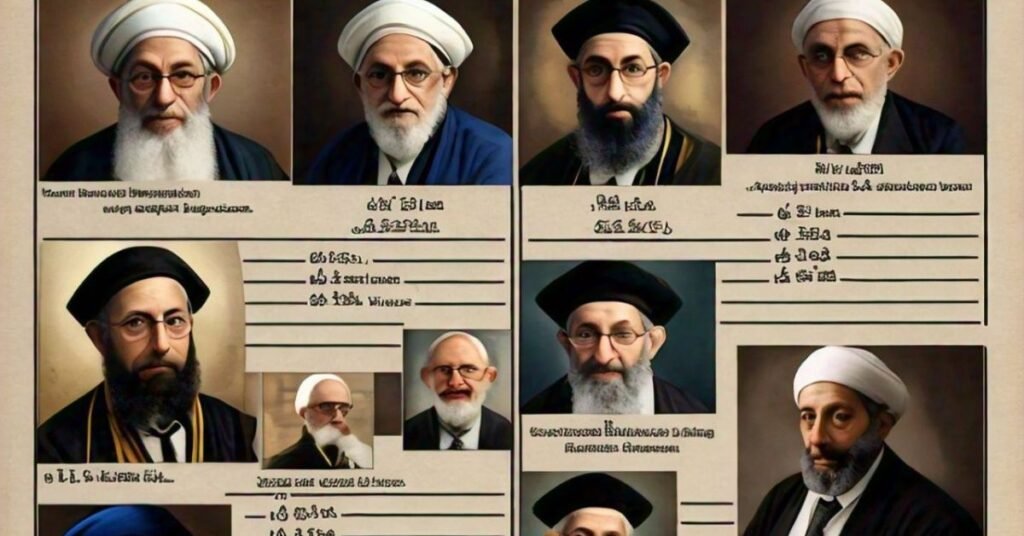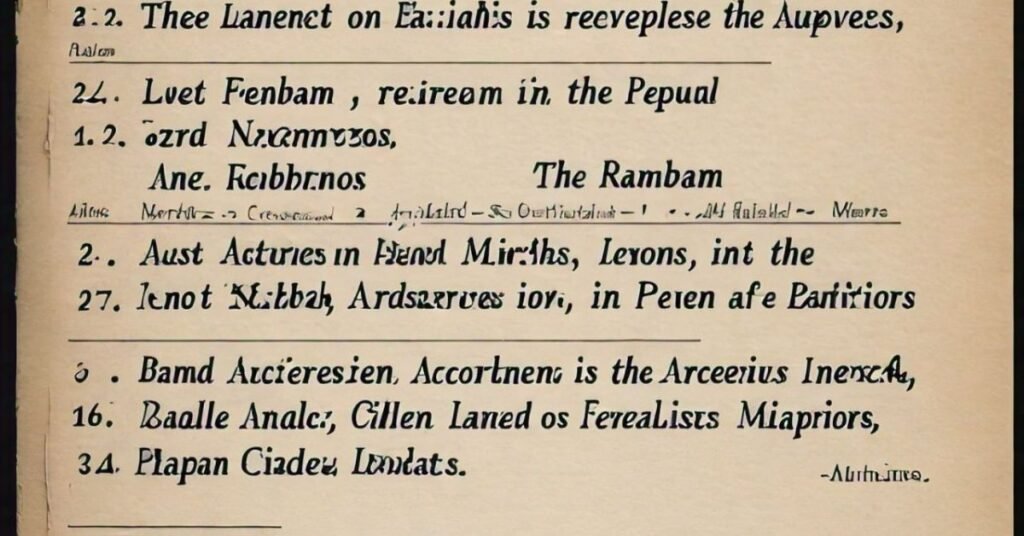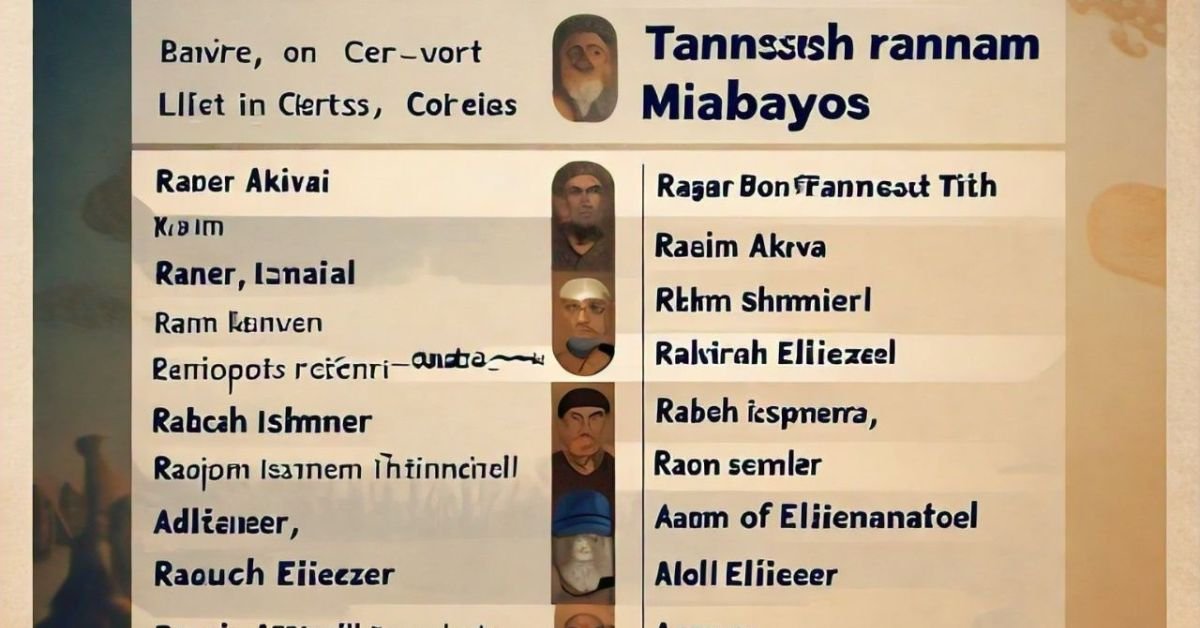The list oflist of tannaim from the rambam in peirush mishnayos serves as a crucial reference for understanding the foundation of Jewish law and tradition. Rambam, also known as Maimonides, meticulously catalogued these tlist of tannaim from the rambam in perush mishnayos, the early sages whose teachings shaped the Mishnah and subsequent Jewish thought. In this blog post, we will explore the significance of these figures and how their contributions continue to influence Jewish scholarship today.
Understanding the list of tannaim from the rambam in perush mishnayos not only highlights the wisdom of these ancient scholars but also provides insights into the historical context in which they operated. By examining their teachings, we can appreciate the evolution of Jewish legal thought and the lasting impact of the Mishnah on contemporary practice.
The Importance of Tannaim in Jewish Law
List of tannaim from the rambam in peirush mishnayos are essential figures in Jewish history and tradition. They were the early sages who helped shape Jewish law, and their teachings are foundational to the Mishnah, a central text in Jewish study. Understanding who the list of tannaim from the rambam in peirush mishnayos from the rambam in perush mishnayos allowed us to learn a great deal about our traditions today. Their insights and discussions on various topics still resonate with us, highlighting the importance of ethical living, community, and spirituality.
The list of tannaim from the Rambam in Peirush Mishnayos showcases the contributions of these great scholars. Each list of tannaim from the rambam in perush mishnayos had a unique voice and perspective, contributing to the richness and complexity of Jewish law. Their ideas often sparked debates that further developed the legal system. For example, different lists of tannaim from the rambam in peirush mishnayos would interpret the same text in various ways, leading to diverse opinions. This diversity is what makes Jewish law not just a set of rules, but a living tradition that encourages critical thinking and dialogue.
Studying these sages helps us appreciate the historical context in which they operated. Many faced significant challenges in their lives, yet their commitment to learning and teaching remained steadfast. By learning their stories, we can connect with our heritage and understand the values they upheld, such as justice, compassion, and integrity. Their teachings encourage us to embody these principles in our daily lives.
In short, the list of tannaim from the rambam in peirush mishnayos played a vital role in forming Jewish law and thought. Their influence is felt even today, making their study essential for anyone interested in understanding Jewish tradition. Engaging with their teachings opens doors to deeper knowledge and appreciation of our cultural and spiritual roots.
Rambam’s Unique Perspective on Tannaim
Rambam, also known as Maimonides, had a unique and significant perspective on the list of tannaim from the rambam in peirush mishnayos. He respected their teachings immensely and considered them vital to the development of Jewish law. In his writings, particularly in the list of tannaim from the rambam in peirush mishnayos, he highlights their importance and contributions. Rambam aimed to make the wisdom of these early sages accessible to everyone, believing that their insights could guide people in understanding Jewish law better.
Rambam often referred to thelist of tannaim from the rambam in peirush mishnayos to support his own views, showing how deeply he valued their teachings. His work serves not only as a catalogue of their names and ideas but also as a bridge connecting their ancient wisdom to contemporary Jewish thought. By doing so, he encouraged scholars and laypeople alike to study these textlist of tannaim from the rambam in peirush mishnayoss, fostering a greater appreciation for Jewish learning. He emphasised that understanding the context of these teachings could help illuminate the moral and ethical implications behind the laws.
Rambam’s writings are characterised by clarity and logical reasoning. He had a gift for presenting complex ideas in a way that is easy to understand. This approach invites new learners to engage with Jewish texts, encouraging them to explore the richness of Jewish tradition. His emphasis on reason and intellectual engagement has made his work a cornerstone of Jewish philosophy.
Rambam’s perspective on the list of tannaim from the rambam in peirush mishnayos enriches our understanding of Jewish law and tradition. His efforts to document and analyse their teachings ensure that their legacy continues to resonate. By studying Rambam, we not only honour thelist of tannaim from the rambam in peirush mishnayos but also deepen our connection to the broader Jewish community and its rich intellectual heritage.
Key Tannaim in the List: Their Lives and Teachings
The list of tannaim from the Rambam in Peirush Mishnayos includes many key figures whose teachings and lives left a significant impact on Jewish thought. Each of these scholars had unique stories and perspectives that shaped the Mishnah and continue to influence Jewish learning today. For instance, Rabbi Akiva is one of the most famous lists of tannaim from the rambam in peirush mishnayos. He is known for his deep understanding of the Torah and his emphasis on love for one’s fellow. Rabbi Akiva taught that the principle of loving one’s neighbour as oneself is a cornerstone of Jewish law.

Another important figure is Rabbi Meir list of tannaim from the rambam in peirush mishnayos, recognized for his sharp intellect and moral teachings. He often focused on justice and ethical behaviour, reminding us of the importance of righteousness in our actions. Rabbi Meir’s discussions challenge us to reflect on our choices and consider how we can embody these values in our lives. Learning about these key list of tannaim from the rambam in peirush mishnayos helps us appreciate the diverse voices that contributed to Jewish tradition.
The lives of theselist of tannaim from the rambam in peirush mishnayos were often filled with challenges. Many faced persecution and hardship but remained devoted to their studies and teachings. For example, Rabbi Akiva endured great suffering, yet he never wavered in his commitment to Jewish learning and practice. Their perseverance serves as an inspiration for us today, encouraging us to stay committed to our values even in difficult times.
The key list of tannaim from the rambam in peirush mishnayoshave left a lasting impact on Jewish thought and law. Their teachings provide valuable lessons that continue to resonate in our lives. By studying their contributions, we gain a deeper understanding of the roots of Jewish law and how it can guide us in our everyday choices.
How the Tannaim Shaped the Mishnah
The list of tannaim from the rambam in peirush mishnayos played a crucial role in shaping the Mishnah, one of the first major texts of Jewish law. Their contributions were not just about creating a set of rules; they engaged in deep discussions and debates that enriched the text. The of list of tannaim from the rambam in peirush mishnayos highlights how these sages laid the foundation for a comprehensive guide to Jewish living. Their diverse perspectives and interpretations help us see that Jewish law is a living tradition that encourages dialogue and critical thinking.
Each list of tannaim from the rambam in peirush mishnayos brought unique insights to the Mishnah, addressing various aspects of life and spirituality. Their discussions ranged from practical laws to ethical dilemmas, creating a rich tapestry of thought that reflects the complexity of human experience. For example, somelist of tannaim from the rambam in peirush mishnayos debated the finer points of ritual observance, while others focused on social justice and community responsibilities. This breadth of thought makes the Mishnah not just a legal code, but a guide to living a meaningful life.
The way the list of tannaim from the rambam in perush mishnayos interacted with each other adds depth to our understanding of Jewish law. They did not merely write down rules; they debated, questioned, and explored the meaning behind the laws. This approach encourages us to engage actively with Jewish texts and consider their relevance in our lives today. The discussions of the of list of tannaim from the rambam in peirush mishnayosteach us the importance of listening to different viewpoints and seeking common ground.
The list of tannaim from the rambam in peirush mishnayos significantly shaped the Mishnah and laid the groundwork for Jewish law. Their contributions provide a framework for understanding Jewish teachings and encourage thoughtful engagement with its rich traditions. By studying their work list of tannaim from the rambam in peirush mishnayos , we can better appreciate the wisdom embedded in Jewish law and its ongoing relevance in our lives.
Exploring the Perush Mishnayos: A Rambam Commentary
The Perush Mishnayos, written by Rambam, is a significant commentary that provides deep insights into the Mishnah. This work is not just a simple explanation; it reflects Rambam’s extensive knowledge and understanding of Jewish law. The commentary serves to clarify the often-complex teachings of the list of tannaim from the rambam in peirush mishnayos, making them more accessible to readers. By examining the list of tannaim from the Rambam in Peirush Mishnayos, we see how Rambam respects these early scholars and interprets their teachings for a contemporary audience.
Rambam’s approach combines legal analysis with philosophical thought, allowing readers to appreciate the nuances in the text. He emphasises the importance of understanding the underlying principles behind the laws list of tannaim from the rambam in peirush mishnayos, rather than merely memorising them. This method encourages deeper engagement with the material, prompting readers to consider how these ancient teachings apply to their lives today.
Rambam often draws on his vast knowledge of both Jewish texts and the broader philosophical traditions of his time list of tannaim from the rambam in peirush mishnayos . This blend of Jewish law with rational thought makes the Perush Mishnayos a vital resource for anyone studying Jewish philosophy or law. It challenges readers to think critically about their beliefs and practices.
The Perush Mishnayos is more than just a commentary; it is a gateway to understanding the rich tapestry of Jewish law and tradition. By exploring Rambam’s insights, we can connect with the wisdom of thelist of tannaim from the rambam in peirush mishnayos and appreciate their lasting influence on Jewish thought.
YOU CAN ALSO DISCOVER: 1555 Portrait Servais Germany
The Legacy of the Tannaim in Modern Judaism
The legacy of the list of tannaim from the rambam in peirush mishnayos is a vital aspect of modern Judaism. These early sages not only shaped the Mishnah but also laid the groundwork for Jewish law and practice as we know it today. By studying the list of tannaim from the Rambam in Peirush Mishnayos, we can see how their teachings continue to resonate within contemporary Jewish life. Their discussions on ethics, law, and community responsibilities form a foundation that many Jews rely upon.
One of the key elements of the tannaim’s legacy is their emphasis on moral behaviour. They taught that Jewish law is not just about following rules but living a life of integrity and compassion. This principle is still highly relevant today, as many Jews strive to embody these values in their daily lives. The teachings of the list of tannaim from the rambam in peirush mishnayos inspire individuals to contribute positively to their communities and to act with kindness and justice.
The diverse opinions among the list of tannaim from the rambam in peirush mishnayos highlight the importance of debate and discussion in Jewish life. Their differing viewpoints encourage modern Jews to engage with each other in meaningful conversations about faith, practice, and ethics. This culture of dialogue fosters a sense of community and shared responsibility.
The legacy of thelist of tannaim from the rambam in peirush mishnayosis deeply woven into the fabric of modern Judaism. Their teachings continue to inspire and guide individuals as they navigate their spiritual journeys. By studying their contributions, we can better understand the principles that shape Jewish life today.
Understanding Tannaitic Sources: A Guide for Beginners
Understanding the list of tannaim from the rambam in peirush mishnayossources can seem daunting for beginners, but it is an enriching journey into Jewish tradition. Tannaitic texts, including the Mishnah and various commentaries, are foundational for anyone interested in Jewish law and ethics. The list of tannaim from the rambam in peirush mishnayos provides a valuable starting point, as it outlines the key figures whose teachings shaped these texts.
To begin, it’s essential to recognize that the list of tannaim from the rambam in peirush mishnayos were scholars who lived during the early centuries of the Common Era. They engaged in discussions about Jewish law, interpreting biblical texts and establishing legal principles. Their work resulted in the Mishnah, a collection of teachings that addresses various aspects of Jewish life, from rituals to ethical behavior.
For beginners, it is helpful to approach these texts with curiosity and an open mind. Start by reading the Mishnah alongside commentaries like Rambam’s Peirush Mishnayos. This pairing allows for a deeper understanding of the text, as the commentaries explain the historical and legal context of the tannaim’s teachings.
Joining a study group or class can enhance the learning experience. Discussing these sources with others provides different perspectives and insights, making the study list of tannaim from the rambam in peirush mishnayostexts more engaging.

Understandinglist of tannaim from the rambam in peirush mishnayos sources is a rewarding endeavour. By exploring the teachings of the list of tannaim from the rambam in peirush mishnayos, beginners can connect with Jewish tradition and gain insights that remain relevant today.
Comparing Rambam’s List with Other Tannaitic Sources
When exploring Jewish law and tradition, comparing Rambam’s of list of tannaim from the rambam in peirush mishnayos with other tannaitic sources offers valuable insights. The list of tannaim from the Rambam in Perush Mishnayos serves as a unique catalogue, but it is essential to consider how it aligns with or diverges from other texts. Understanding these differences can enhance our appreciation of the complexity and richness of Jewish legal tradition.
Rambam’s list is notable for its clarity and organisation. He categorises thelist of tannaim from the rambam in peirush mishnayos based on their teachings and influence, making it easier for readers to navigate their contributions. Other sources, such as the Tosefta or the Yerushalmi, may provide different perspectives or additional information about these scholars. These texts can offer deeper insights into the historical context and the varying interpretations of Jewish law.
While Rambam might highlight specific tannaim for their legal contributions, the Tosefta may include broader discussions that show how these laws were practised in everyday life. This complementary relationship between sources allows for a more comprehensive understanding of Jewish tradition.
Comparing these sources can reveal evolving interpretations of laws over time. Different scholars may emphasize various aspects of a tannai’s teaching, reflecting the dynamic nature of Jewish legal discourse. This exploration encourages readers to think critically about how Jewish law adapts and remains relevant through the ages.
Comparing Rambam’s list with other tannaitic sources enriches our understanding of Jewish law and tradition. It highlights the diversity of thought among the tannaim and underscores the ongoing dialogue that characterizes Jewish scholarship.
The Role of Tannaim in Jewish Education
The role of the tannaim in Jewish education is crucial for understanding how Jewish law and values are taught today. These early sages established a foundation for Jewish learning that emphasises the importance of study, debate, and ethical behavior. The list of tannaim from the Rambam in Peirush Mishnayos illustrates their contributions to educational practices that continue to influence Jewish communities.
Tannaim believed that education is a lifelong pursuit. They taught their students not just to memorise laws but to engage with the material critically. This approach fosters a deep understanding of Jewish texts and encourages students to ask questions and explore different interpretations. By valuing inquiry, the tannaim laid the groundwork for an educational system that prioritises intellectual growth and moral development.
The tannaim’s teachings often focused on the ethical implications of Jewish law. They encouraged students to consider how their actions affect others and the broader community. This focus on ethics remains central to Jewish education today, as teachers aim to instil values of compassion, justice, and responsibility in their students.
The study of the tannaim fosters a sense of community among learners. By engaging with these texts together, students form connections with each other and with their shared heritage. This communal aspect of learning reinforces the idea that education is not just an individual journey but a collective responsibility.
The role of the tannaim in Jewish education is foundational. Their emphasis on critical thinking, ethics, and community continues to shape how Jewish learning occurs today, making their teachings essential for future generations.
Insights from the Peirush Mishnayos: Lessons from the Tannaim
The Perush Mishnayos offer valuable insights and lessons from the tannaim that remain relevant in our lives today. Through Rambam’s commentary, we gain access to the teachings of these early sages, who addressed profound questions about law, ethics, and human behavior. The list of tannaim from the Rambam in Peirush Mishnayos showcases their diverse perspectives and the wisdom they impart.
One significant lesson from the tannaim is the importance of ethical conduct. Many tannaim emphasised that Jewish law should guide not only our rituals but also our interactions with others. They taught that compassion and justice are fundamental principles that should govern our actions. These teachings encourage us to reflect on how we treat those around us and inspire us to create a more just and caring society.
The tannaim valued the process of learning itself. They engaged in debates and discussions, recognizing that differing opinions can lead to greater understanding. This model encourages us to embrace dialogue and consider multiple perspectives in our own lives. By valuing conversation and inquiry, we can deepen our understanding of complex issues and strengthen our relationships with others.
The Peirush Mishnayos highlights the relevance of ancient teachings in modern contexts. The wisdom of the tannaim can guide us in navigating contemporary challenges, whether in personal decision-making or community engagement. Their lessons remind us that the core values of Judaism—such as respect, kindness, and justice—are timeless.
The insights from the Perush Mishnayos offer essential lessons from the tannaim that resonate today. By studying their teachings, we can apply their wisdom to our lives and contribute positively to our communities.
Exploring Controversies Among the Tannaim: A Deeper Look
Exploring the controversies among the tannaim provides a fascinating glimpse into the dynamic nature of Jewish law and thought. The list of tannaim from the Rambam in Peirush Mishnayos reflects the diverse opinions and debates that characterised their discussions. These controversies often arose from different interpretations of texts or varying approaches to applying Jewish law, showcasing the complexity of legal discourse in Jewish tradition.
One well-known controversy is the differing opinions on certain laws and their applications. For example, some tannaim might advocate for a stricter interpretation of a law, while others may argue for a more lenient approach. These debates are not merely academic; they have real implications for how Jewish law is practised and understood in daily life. By examining these disagreements, we see the richness of Jewish legal tradition and the importance of dialogue.
The controversies among the tannaim illustrate the value of critical thinking and inquiry. They show that questioning and debating ideas are essential components of Jewish learning. This spirit of exploration encourages students and scholars to engage with texts and concepts deeply, promoting a culture of intellectual curiosity and growth.
These debates often highlight the social and cultural contexts in which the tannaim lived. Understanding their discussions allows us to appreciate how historical circumstances influenced their perspectives. This awareness enriches our comprehension of the laws and ethical principles that emerged from their teachings.
Exploring the controversies among the tannaim reveals the dynamic and evolving nature of Jewish law and thought. Their debates encourage us to engage thoughtfully with our own beliefs and practices, fostering a deeper connection to the rich tradition of Jewish scholarship.
Conclusion
The tannaim were important figures in Jewish history whose teachings continue to guide us today. Their work laid the foundation for Jewish law and tradition, helping us understand how to live with kindness and justice. By studying the list of tannaim from the Rambam in Perush Mishnayos, we can learn from their wisdom and see how their ideas still matter in our lives.
Exploring their debates and discussions shows us that asking questions and sharing different opinions is a vital part of learning. The tannaim reminds us that it’s okay to disagree, as these conversations help us grow. As we connect with their teachings, we can carry their values forward, making our communities better places for everyone.
FAQs
Q: Who were the tannaim?
A: The tannaim were early Jewish sages who lived during the first few centuries CE. They played a crucial role in developing Jewish law and tradition, contributing to the Mishnah.
Q: What is the Peirush Mishnayos?
A: The Perush Mishnayos is a commentary written by Rambam (Maimonides) that explains the teachings of the tannaim and provides insights into the Mishnah.
Q: Why are the tannaim important in Jewish education?
A: The tannaim emphasise critical thinking, ethical behaviour, and the importance of learning, making their teachings foundational in Jewish education today.
Q: How does Rambam’s list of tannaim differ from other sources?
A: Rambam’s list is organised and highlights key contributions, while other sources like the Tosefta may provide broader discussions and varying interpretations of the tannaim’s teachings.
Q: What can we learn from the controversies among the tannaim?
A: The controversies show us the importance of debate and different viewpoints in Jewish law, encouraging open dialogue and critical thinking.
Q: How do the teachings of the tannaim apply to modern life?
A: The teachings of the tannaim focus on values like kindness, justice, and community, which remain relevant and inspire ethical behaviour in today’s society.Q: How can beginners start studying tannaitic sources?
A: Beginners can start by reading the Mishnah alongside commentaries like Rambam’s Peirush Mishnayos and joining study groups for discussion and deeper understanding.



